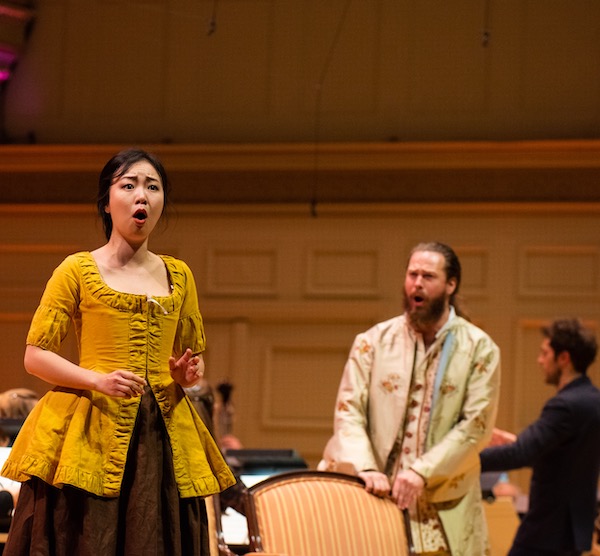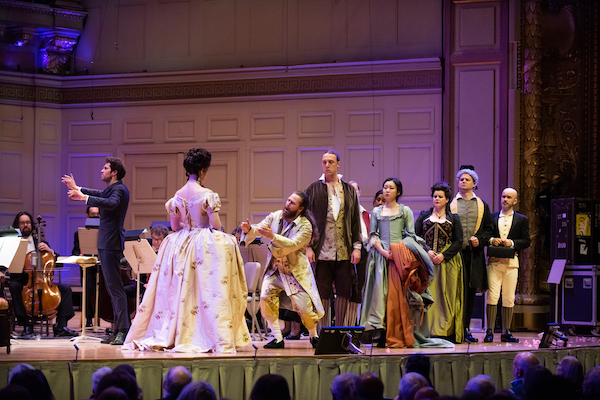Handel & Haydn Society serves up a delightful and sparkling “Marriage of Figaro”

Ying Fang is Susanna and Cody Quattlebaum the Count with Raphaël Pichon conducting the Handel and Haydn Society in a performance of Mozart’s The Marriage of Figaro Thursday night at Symphony Hall. Photo: Sam Brewer
The Handel and Haydn Society might be the country’s oldest performing arts institution, but it certainly is projecting—and performing with–the vigor of youth this week. On Monday, the ensemble announced the appointment of 45-year-old Jonathan Cohen as their new artistic director, effective in 2023.
Then, on Thursday at Symphony Hall, H&H gave its first-ever semi-staged performance of Wolfgang Mozart’s Le nozze di Figaro. For the occasion, the 38-year-old Raphaël Pichon conducted.
Though today it’s firmly ensconced in the canon, it’s worth noting that The Marriage of Figaro isn’t the work of the old or the established. Rather, it’s the product of a 30-year-old composer and his 36-year-old librettist, Lorenzo da Ponte. Even as they were adapting a play written by a 46-year-old Pierre de Beaumarchais, its convoluted plot—a blend of love, betrayal, lust, mistaken identity, and, ultimately, redemption (unfolding, improbably, in a single day)—is one of opera’s most vigorous and playful.
Perhaps it was fitting that Thursday’s dynamic cast broadly fit the original creative team’s age demographic. Not only were they uniformly impressive, but, in a couple of instances, the night’s singing was downright exceptional.
As the titular hero, bass Krzysztof Baczyk brought oafish charm to his role as well as a warm-toned, robust voice. While his lower tessitura sounded underpowered at the start, by the time “Non più andrai” rolled around at the end of Act 1 he had settled in nicely. For the rest of the night, either alone or in ensembles, Baczyk had no issues projecting with resonance and personality.
Neither did the evening’s captivating Susanna, Ying Fang. The young soprano is already a fully-fledged star: if her clean projection and perfectly calibrated tone didn’t give it away, “Deh vieni non tardar,” with its flawless sculpting and absorbing inward focus, literally stopped the show in its tracks for the night’s lengthiest mid-act ovation.
Fang’s pristinely phrased and colored account of that aria was but one highlight from a larger performance that felt and looked perfectly natural. Fang’s chemistry with Baczyk, for instance, was electric: one could easily imagine the pair as a bickering but loving couple in real life.
She connected just as persuasively with the rest of the cast. Fang’s duet with MaryAnn McCormick’s Marcellina (“Via resti servita”) was wickedly catty, while her interactions with Paula Murrihy’s Cherubino were richly sympathetic.
Most riveting was Fang’s synergy with Jacquelyn Stucker’s Countess. Here we had two artists at the start, one expects, of exceptional careers. They played off one another brilliantly, Fang’s lean, agile instrument proving a perfect complement for Stucker’s creamy, more opulent one.
The latter was put to exceptional use from her first appearance in Act 2: “Porgi amor” glowed as did her entrancing “Dove sono,” in which Stucker offered a series of embellishments during its recapitulation.
Yet her triumph in the part was as much a result of terrific singing as it was compelling acting. The Countess is a wronged woman carrying on proudly despite all that has befallen her. Stucker radiated righteous nobility—but also grace, humanity, and vulnerability. Hers was a three-dimensional portrayal that palpably and subtly underlined the tragedy of this character’s circumstances.
It was given potent visual illustration in the stark contrast between happy couples (Figaro and Susanna, Bartolo and Marcellina) and the unhappy one (the Count and Countess) at the end of Act 3. Accordingly, the Countess’s resolution of all the opera’s threads, particularly her forgiveness of her philandering husband, at the end of the opera packed a real emotional punch.

The conclusion of Act IV of The Marriage of Figaro Thursday night at Symphony Hall. Photo: Sam Brewer
Granted, even then it was an open question how long Cody Quattlebaum’s Almaviva would remain faithful to his wife. Given how strongly the bass-baritone projected the Count’s devil-may-care attitude across the night, his quick plea at the end for the Countess’s forgiveness rang a touch hollow. Even so, Quattlebaum’s vocalism—especially “Hai già vinta la causa” and “Contessa perdono” were intensely sung, though he was sometimes swamped in ensembles.
In other roles, Scott Conner swaggered mightily as both Don Bartolo and the hard-drinking gardener Antonio. Zachary Wilder was terrifically hammy as Curzio and ingratiating as the obnoxious singing teacher, Don Basilio. His ringing account of “In quegl’anni in cui val poco” was one of the night’s several laugh-out-loud highlights.
McCormick’s Marcellina was, likewise, a winning comic foil. Murrihy’s Cherubino sounded occasionally breathless though Maya Kherani proved a supple Barbarina. The night’s handful of contributions from the H&H Chorus were hearty and colorful.
Pichon presided over it all with a sure hand. His approach to the score eschewed the extremes of undue sentimentality and rigidity. What it offered, instead, was shapeliness infused with dancing energy and beguiling instrumental colors. The H&H Orchestra’s woodwinds, in particular, shone throughout the evening, nowhere more impressively than in Cherubino’s “Voi che sapete.”
Having the orchestra seated behind the singers caused some problems of coordination and balance, but the sheer vigor of the performance carried the day. This was aided by costumes and wigs (from, respectively, Molly Irelan and Rachel Padula-Shufelt) that placed the action firmly in the 18th century. The libretto’s supertitles, projected above the stage, rendered da Ponte’s celebrated text in lucid, unstilted English. Meanwhile, James Darrah’s direction made a virtue of the limits of a stage extension: a couple of chairs, some instrument cases, a tarp, and a bevy of music stands comprised the minimalist set.
True, this led to some confusion during the complicated parts of Acts 2 and 4. But it cleverly used the space—Cherubino’s escape from the Countess’s chamber, for instance, involved a dash down Symphony Hall’s middle aisle—and the larger performing ensemble. Happily, in these meta moments (Figaro high-fiving and conducting the chorus as he goes to celebrate his wedding, Susanna handing Pichon Cherubino’s song in Act 2, etc.), Darrah practiced restraint: here’s a director who understands when enough is enough.
Ultimately, his approach served to focus one’s attention on the music. Given the haphazard nature of opera stagings these days, that’s something worth celebrating. Surely, any production that can illuminate and revitalize the structural, dramatic, and musical richness of The Marriage of Figaro as winningly as this one does, in any day or age, is pretty much worth its weight in gold.
The Marriage of Figaro repeats 7 p.m. Friday at Symphony Hall. handelandhaydn.org
Posted in Performances




Posted Nov 22, 2022 at 8:50 am by Richaard B. Beams
Greetings – Thanks for your fine and thorough review of The Marriage of Figaro, which was indeed a terrific performance.
I especially appreciated your comments re the balance problems between the early-instrument orchestra, set well back on the stage, and the singers. Indeed, loving and knowing the work as I do, I perhaps let this bother me more than I should have, since as you correctly state, in the final analysis the sheer vigor of the performance (and Pichon’s conducting) carried the day.
Thanks again.